Archive:Architectural, engineering, technical testing and analysis services statistics - NACE Rev. 2
- Data from April 2013. Most recent data: Further Eurostat information, Main tables and Database.
This article presents an overview of statistics for the architectural, engineering, technical testing and analysis services sector in the European Union (EU), as covered by NACE Rev. 2 Division 71; hereafter referred to as architectural and technical services.
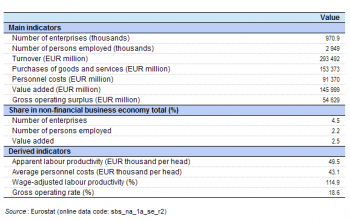



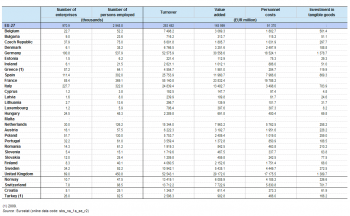
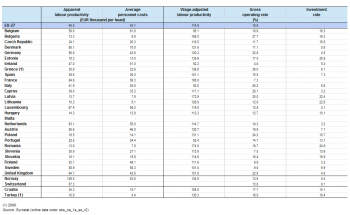

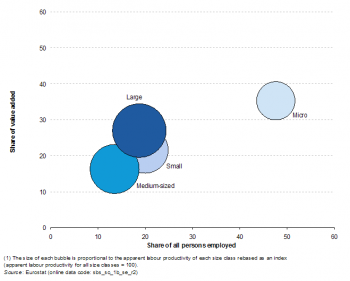
(% share of sectoral total) - Source: Eurostat (sbs_sc_1b_se_r)
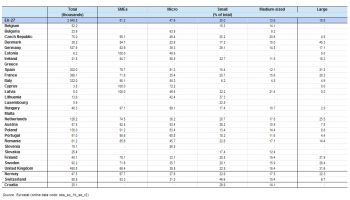
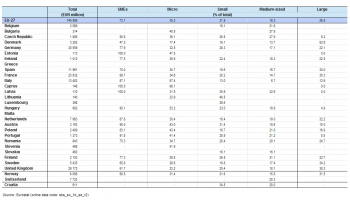
Main statistical findings
Structural profile
The EU-27’s architectural and technical services sector (Division 71) comprised 970.9 thousand enterprises in 2010, employed 2.9 million persons and recorded value added of EUR 146.0 billion. Within the non-financial business economy (Sections B to J and L to N and Division 95) the architectural and technical services sector represented 2.2 % of the total number of persons employed and 2.5 % of value added. Based on these value added and employment measures, the architectural and technical services sector was the second largest activity among the seven NACE divisions included within professional, scientific and technical activities (Section M), smaller only than legal and accounting services (Division 69). Architectural and technical services employed 26.7 % of the professional, scientific and technical activities workforce and accounted for 26.0 % of its value added.
Apparent labour productivity within the EU-27’s architectural and technical services sector in 2010 was EUR 49.5 thousand of value added per person employed, above the non-financial business economy average of EUR 44.8 thousand per person employed, but slightly below the professional, scientific and technical activities average of EUR 50.7 thousand per person employed. At EUR 43.1 thousand per employee, average personnel costs within the EU-27’s architectural and technical services sector were much higher than the non-financial business economy average (EUR 30.9 thousand per employee) and just above the professional, scientific and technical activities average (EUR 42.9 thousand per employee).
The wage-adjusted labour productivity ratio combines the two previous indicators and shows the extent to which value added per person employed covers average personnel costs per employee. As the architectural and technical services sector’s apparent labour productivity and average personnel costs were broadly similar to those for all professional, scientific and technical activities in 2010 it is unsurprising that the wage-adjusted labour productivity ratios were also similar: 114.9 % for the EU-27’s architectural and technical services sector compared with 118.2 % for all professional, scientific and technical activities, well below the wage-adjusted labour productivity ratio for the whole of the non-financial business economy (144.8 %).
The gross operating surplus for the EU-27’s architectural and technical services sector was equivalent to 18.6 % of turnover, which was almost identical to the gross operating rate for professional, scientific and technical activities (18.7 %) and close to double the non-financial business economy average (10.1 %).
Sectoral analysis
The EU-27’s architectural and engineering activities (Group 71.1) subsector dominated the architectural and technical services sector, employing 2.5 million persons and generating value added of EUR 126.4 billion in 2010. It was 6.3 to 6.5 times as large as the technical testing and analysis (Group 71.2) subsector in 2010, depending on whether the analysis was made in terms of employment or value added.
However, in terms of labour productivity and average personnel costs these two subsectors were very similar. The EU-27’s architectural and engineering activities subsector recorded apparent labour productivity of EUR 49.7 thousand per person employed in 2010 which was EUR 1.2 thousand per person more than for the smaller technical testing and analysis subsector. Average personnel costs of EUR 43.5 thousand per employee for architectural and engineering activities were also slightly higher (by EUR 2.4 thousand per employee) than the corresponding ratio for technical testing and analysis. This closeness resulted in nearly identical wage-adjusted labour productivity ratios: 114.2 % for architectural and engineering activities and 118.0 % for technical testing and analysis.
One indicator where the two subsectors did show more of a difference was the gross operating rate. The EU-27’s architectural and engineering activities subsector produced more than 90 % of the sector’s gross operating surplus and this high share translated into a higher gross operating rate (19.2 %) than for technical testing and analysis (14.5 %). For technical testing and analysis, the gross operating rate was below the professional, scientific and technical activities average (18.7 %) but above the non-financial business economy average (10.1 %).
Country analysis
Germany contributed just over one fifth (20.9 %) of EU-27 value added in the architectural and technical services sector in 2010, just ahead of the share recorded for the United Kingdom (20.0 %); France was the only other EU Member State to record a double-digit share (16.3 %).
The architectural and technical services sector accounted for a higher share (3.2 %) of non-financial business economy value added in the United Kingdom than in any other EU Member State and as such it was the most specialised. Denmark, France, the Netherlands and Slovenia were also relatively highly specialised, as the contribution of the architectural and technical services sector to non-financial business economy value added was at least 2.7 % in all four of these Member States. Among the non-member countries there was also a high degree of specialisation within the architectural and technical services sector, as its share of non-financial business economy value added stood at 2.8 % in Croatia, 3.1 % in Switzerland, and peaked at 3.3 % for Norway. This was the third highest degree of specialisation (relative to the EU-27) among any of the NACE divisions within the Norwegian non-financial business economy.
The United Kingdom’s leading position was also reflected at a more detailed level as it recorded the highest share of EU-27 value added for the architectural and engineering activities subsector, and was also the most specialised EU Member State for this activity. Germany had the highest level of value added for technical testing and analysis, while Latvia was the most specialised Member State.
Four EU Member States recorded wage-adjusted labour productivity ratios below 100 % in the architectural and technical services sector in 2010, namely Belgium, Hungary, Ireland and Italy, indicating that average personnel costs were higher than apparent labour productivity. By contrast, the wage-adjusted labour productivity ratio in Bulgaria was, at 195.0 %, the highest among the Member States. Bulgaria was also the only Member State to record a higher wage-adjusted labour productivity ratio for architectural and technical services than for its non-financial business economy as a whole in 2010.
The relatively high gross operating rate observed for the EU-27’s architectural and technical services sector in 2010 was mainly due to high rates for several large EU Member States, notably Italy (40.2 %), Germany (22.9 %) and the United Kingdom (22.8 %), while Bulgaria, Cyprus, Poland and Latvia also recorded rates of at least 20.0 %. Gross operating rates for architectural and technical services were higher than the average rates for the whole of the non-financial business economy in nearly all Member States, the main exceptions being Italy and Ireland, where the gross operating rate for architectural and technical services was around 10 percentage points lower than the non-financial business economy average, while the difference in Sweden and Slovenia was around 1 percentage point.
Size class analysis
Irrespective of whatever measure of size was used to analyse the data, micro enterprises (employing fewer than 10 persons) made the largest contribution to the EU-27’s architectural and technical services sector. There were 910 thousand micro enterprises active within the architectural and technical services sector in 2010: they employed 1.4 million persons and generated value added of EUR 51.5 billion. In relative terms, they provided work to almost half (47.6 %) of the EU-27’s workforce within the architectural and technical services sector, while generating slightly more than one third (35.3 %) of sectoral value added. The apparent labour productivity of micro enterprises within the EU-27’s architectural and technical services sector reflected these different shares of employment and value added and stood at EUR 36.7 thousand per person employed (compared with a sectoral average for all enterprises of EUR 49.5 thousand per person employed).
Large enterprises (employing 250 or more persons) accounted for more than one quarter (26.9 %) of the EU-27’s value added within the architectural and technical services sector in 2010. This was considerably higher than the share (18.8 %) of large enterprises in the sectoral workforce. As a result, the apparent labour productivity of large enterprises within the EU-27’s architectural and technical services sector was EUR 71.7 thousand per person employed, almost double that recorded for micro enterprises.
This general pattern of micro enterprises accounting for the largest share (of value added and employment) in the architectural and technical services sector was repeated in the majority of EU Member States. Denmark and the United Kingdom were the only countries to report that micro enterprises did not employ the largest share of the architectural and technical services workforce in 2010. Rather, there were more persons employed in large enterprises in each of these two Member States, 45.3 % and 31.6 % of sectoral employment respectively. A similar pattern was reported in Norway, where large enterprises accounted for 32.3 % of the sectoral workforce, slightly higher than the share recorded among micro enterprises (27.6 %).
Denmark and the United Kingdom were joined by Sweden and the Netherlands as the only four EU Member States where large enterprises accounted for the highest share of value added within the architectural and technical services sector; the same was also true in Norway (where large enterprises generated 31.5 % of sectoral value added, just 0.1 percentage points higher than the share recorded for micro enterprises). The majority of the remaining EU Member States recorded their highest share of sectoral value added among micro enterprises, although the two Baltic Member States of Latvia and Lithuania were further exceptions to this rule, as they recorded their highest shares of value added among small enterprises (employing 10 to 49 persons).
Data sources and availability
The analysis presented in this article is based on the main dataset for structural business statistics (SBS) and size class data, all of which are published annually.
The main series provides information for each EU Member State as well as a number of non-member countries at a detailed level according to the activity classification NACE. Data are available for a wide range of variables.
In structural business statistics, size classes are generally defined by the number of persons employed. A limited set of the standard structural business statistics variables (for example, the number of enterprises, turnover, persons employed and value added) are analysed by size class, mostly down to the three-digit (group) level of NACE. The main size classes used in this article for presenting the results are:
- small and medium-sized enterprises (SMEs): with 1 to 249 persons employed, further divided into;
- micro enterprises: with less than 10 persons employed;
- small enterprises: with 10 to 49 persons employed;
- medium-sized enterprises: with 50 to 249 persons employed;
- large enterprises: with 250 or more persons employed.
Context
This article presents an overview of statistics for the architectural and technical services sector in the EU, as covered by NACE Rev. 2 Division 71. This division includes the provision of architectural services such as consulting, design and drafting services, town planning and engineering services such as engineering design and implementation, geophysical, geological and seismic surveying, and mapping services. The architectural and technical services sector also includes the performance of physical, chemical, and other analytical testing services of materials and products, including, for example, testing activities in the field of food hygiene, reliability testing, testing and measuring of environmental indicators, the operation of police laboratories, and the certification of products such as transport equipment.
This NACE division is composed of two groups:
- architectural and engineering activities (Group 71.1);
- technical testing and analysis (Group 71.2).
The information that is presented in this article does not cover test drilling in connection with mining operations (classified as part of mining support service activities, Division 09), research and development activities related to engineering (included as part of scientific research and development, Division 72), or industrial design, aerial photography and interior decorating (which form part of other professional, scientific and technical activities, Division 74).
Further Eurostat information
Publications
Main tables
Database
- SBS – services (sbs_serv)
- Annual detailed enterprise statistics - services (sbs_na_serv)
- Annual detailed enterprise statistics for services (NACE Rev.2 H-N and S95) (sbs_na_1a_se_r2)
- Preliminary results on services, main indicators (NACE Rev.2) (sbs_sc_r2preli)
- SMEs - Annual enterprise statistics broken down by size classes - services (sbs_sc_sc)
- Services broken down by employment size classes (NACE Rev.2 H-N and S95) (sbs_sc_1b_se_r2)
- Annual detailed enterprise statistics - services (sbs_na_serv)
- SBS - regional data - all activities (sbs_r)
- SBS data by NUTS 2 regions and NACE Rev.2, from 2008 onwards (sbs_r_nuts06_r2)
Dedicated section
Source data for tables, figures and maps (MS Excel)
Other information
- Decision 1578/2007/EC of 11 December 2007 on the Community Statistical Programme 2008 to 2012
- Regulation 295/2008 of 11 March 2008 concerning structural business statistics